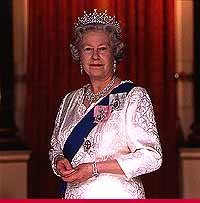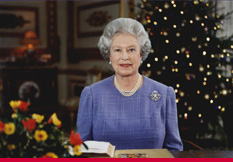HM Queen Elizabeth II:
Introduction To Her Majesty:
The Queen is the United Kingdom's Head of State. As well as carrying out significant constitutional functions, The Queen also acts as a focus for national unity, presiding at ceremonial occasions, visiting local communities, and representing Britain around the world.
The Queen is also Head of the Commonwealth. During her reign she has visited all the Commonwealth countries, going on 'walkabouts' to gain direct contact with people from all walks of life.
The Queen is a constitutional monarch: in other words, she is bound by rules and conventions and cannot rule in an arbitrary way.
The essence of the monarchy today is that The Queen is politically impartial. On almost all matters she acts on the advice of the government of the day. The tasks of making laws, administering justice, and governing and defending the country are carried out by others in The Queen's name. The Monarch thus symbolises the permanence and stability of the nation, which transcends the ebb and flow of party politics.
Ceremonial Dutes:
Ceremonial activities have long been associated with the monarchy. Many traditional ceremonies and other ceremonial functions take place.
Queen in Parliament:Limits began to be placed on the powers of the monarch as far back as 1215 when the barons forced King John to recognise in Magna Carta that they had certain rights. The constitutional monarchy we know today developed in the 18th and 19th centuries, as day-to-day power came to be exercised by Ministers in Cabinet, deriving their authority from Parliaments elected from a steadily widening electorate.
'Queen in Parliament' is the formal title of the British legislature, which consists of the Sovereign, the House of Lords and the House of Commons. The Commons, a majority of whom normally support the government of the day, has the dominant political power.
As constitutional monarch, the Sovereign is required, on the advice of Ministers, to assent to all Bills. The Royal Assent (that is, consenting to a measure becoming law) has not been refused since 1707. The role of the Sovereign in the enactment of legislation is today purely formal, although The Queen has the right to be consulted, to encourage and to warn.

The Queen in Parliament is most clearly demonstrated in the State Opening of Parliament, when The Queen opens Parliament in person, and addresses both Houses in The Queen's Speech. This speech, drafted by the Government and not by The Queen, outlines the Government's policy for the coming session of Parliament and indicates forthcoming legislation. Each session, therefore, begins with The Queen's Speech, and the Houses cannot start their public business until the Speech has been read.
Trooping the Colour:
The Sovereign's birthday is officially celebrated every June by the ceremony of Trooping the Colour on Horse Guards Parade. Although The Queen was born on 21 April, it has long been customary to celebrate the Sovereign's birthday publicly on a day in the summer.
Trooping the Colour is carried out by fully trained and operational troops from the Household Division (Foot Guards and Household Cavalry) on Horse Guards Parade in Whitehall, watched by members of the Royal family, invited guests and members of the public. The ceremony dates back to the early 18th century or earlier, when the colours (flags) of the battalion were carried (or 'trooped') down the ranks so that they could be seen and recognised by the soldiers. Since 1748, this parade has also marked the Sovereign's official birthday and, since Edward VII's reign, the Sovereign has taken the salute in person at Trooping the Colour.

During the ceremony, The Queen is greeted by a royal salute and carries out an inspection of the troops. After the massed bands have performed a musical 'troop', the escorted regimental colour is carried down the ranks; the Foot Guards and the Household Cavalry then march past The Queen. The Queen rides back to Buckingham Palace at the head of her Guards, before taking the salute at the Palace from a dais. The troops then return to barracks. The Queen has taken the salute every year of her reign, except in 1955 when a national rail strike cancelled the event.
A Queen of Public Works:
The Queen's public work as Head of State is well known. This includes attending State events such as opening Parliament and Trooping the Colour, acting as host to visiting Heads of State, conferring honours in Investitures, opening hospitals, visiting schools, factories and charities. The Queen's routine working day is less familiar to anyone outside the Royal Household.
Daily Schedule:
- Morning:
- The Queen begins her ordinary working day by scanning the daily British newspapers.
Every day, 200-300 (and sometimes many more) letters from the public arrive, and are taken to her desk unopened. The Queen chooses a selection to read herself and tells her staff how she would like them to be answered.
In the mornings, The Queen will often see a number of important people: for example, overseas Ambassadors and High Commissioners, newly appointed British Ambassadors, senior members of the Armed Forces on their appointment and retirement, and English bishops and judges on their appointment.
- Afternoon:
- In the afternoons, The Queen frequently goes out on public engagements.
- Evening:
- In the report of the day's parliamentary proceedings, written by one of the Government's Whips, arrives, and The Queen always reads this the same evening.
On some evenings, The Queen may attend a Royal Film première, Variety and Concert performances in aid of charitable causes, or receptions or suppers linked to organisations of which she is Patron.
Through her public and private work, The Queen is well-briefed and well-known; she has met many more people from all walks of life both in this country and overseas than her predecessors. This takes time and effort. Often, one of the last lights on in the Palace at night is The Queen finishing her 'red box' of official papers.

Return to the British Royal Family Site | Return to Royal Watcher Site
Join GeoCities




